A few years ago, I was traveling through Lake Como and made friends with some of the ferry workers. One day, they suggested I try this little hole-in-the-wall restaurant in Varenna on the port side of town. I hadn’t explored that part of Varenna much, as the other side of this small village is “dressed up” much more for tourists. But, always trusting local recommendations, I went to the restaurant that is part of a small hotel called Monte Codeno.
The menu was limited, particularly for someone who doesn’t eat a lot of fish, but the owner suggested a pasta called “Pizzoccheri della Valtellina” (Valtellina is a valley in the Italian Alps, somewhat near Lake Como). When it came out looking all purple and gooey, I wasn’t really convinced… until I tried it and realized it is one of the most wonderful dishes ever! Turns out the pasta is a purplish-brown color because it’s made of buckwheat (and thus gluten-free). The goo is cheese and butter – who can argue with that? Mix in some diced potato and chopped swiss chard, and you have the perfect meal for winter in the Italian Alps!
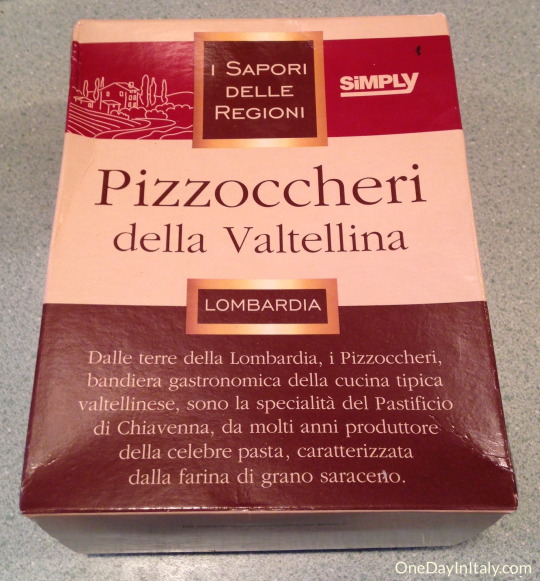
I bought some premade pizzoccheri at a grocery store in Milan. In the US, they’re a little harder to come by, but you can find them on Amazon:
Or, you can make your own (it’s really simple) with buckwheat flour.
However you choose to get your Pizzoccheri pasta, here’s what you’ll need for 6 people:
500g dried pizzoccheri pasta (I used 500g)
300g diced potato (this equals about two medium potatoes, diced about the size of your thumb… unless you have a huge thumb)
250g butter
300g swiss chard (I’ve seen recipes that use savoy cabbage, but I prefer swiss chard)
500g cheese (or slightly less… I used about 400g and it was plenty!) Grate or thinly slice the cheese (it will need to be able to melt quickly). A note about cheeses: in the traditional pizzoccheri, they use a mixture of Casera and Bitto, two Italian mountain cheeses that are difficult to find in the US. I used a mixture of Fontina and Parmigiano, instead, and it worked really well.
2-3 cloves of garlic
5-10 fresh sage leaves (I used dried, rubbed sage, which wasn’t ideal but worked in a pinch)
Optional: about 1/4 teaspoon ground nutmeg
1 small pan
1 large pot
1 deep-sided baking dish
1 colander
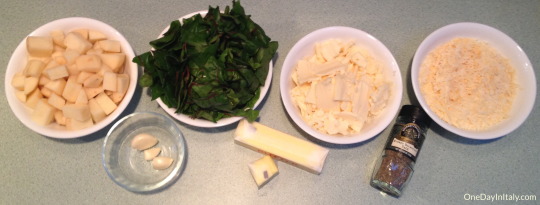
The important thing to manage in the preparation of pizzoccheri is timing as, except for the melted butter, it’s all done in one pot. You want to carefully time each step so that nothing is over- or under-cooked.
Begin by bringing a large pot of salted water to a rolling boil. Add the diced potato and the swiss chard and continue boiling for about 5 minutes.

Then add your dried pizzoccheri.
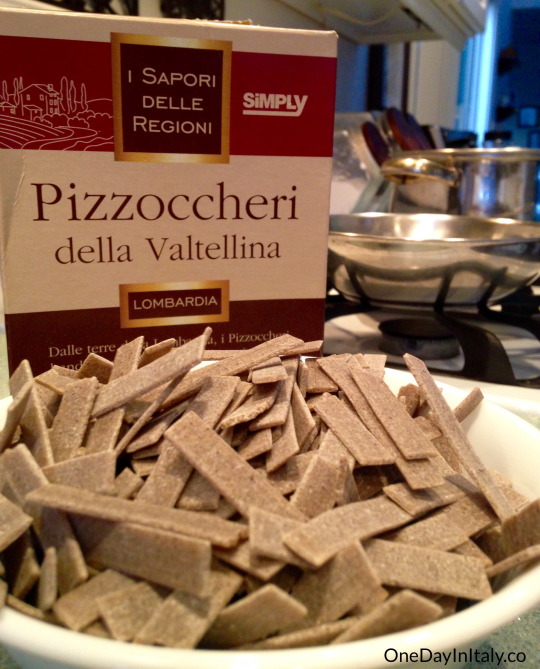
Let everything continue to boil together for the amount of time stated on the pizzoccheri box (12-15 minutes or until the pizzoccheri is al dente).
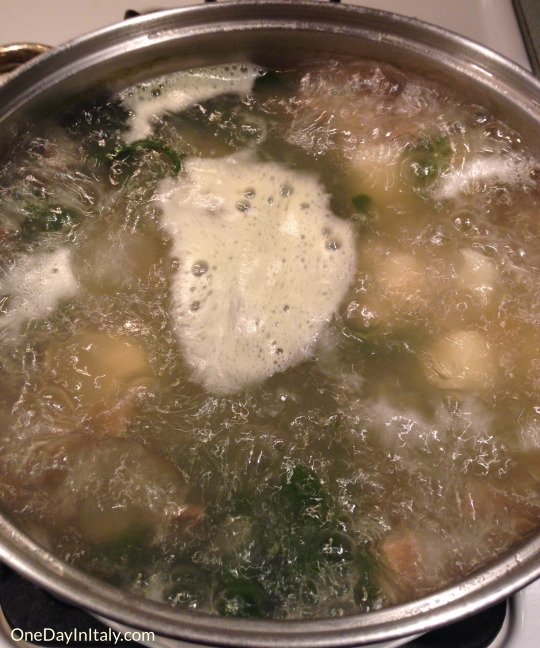
Meanwhile, gently heat the butter, garlic and sage together in a small pan. The goal is for the flavors of the garlic and sage to meld into the butter (you’ll remove the garlic and fresh sage leaves, if you used them, before moving onto the next step). If you want to add a pinch of ground nutmeg, feel free, but it’s not required. You do not want the butter to brown, so keep the heat very low.

When the pizzoccheri is cooked, drain everything in the pot. Now you can begin layering the boiled ingredients with the cheeses.
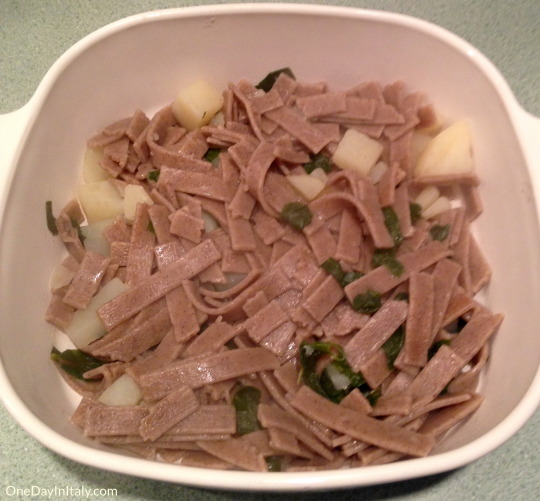
Lay down a thin layer of the pasta, potatoes and swiss chard, then a hearty layer of fontina and parmigiana. You’ll be able to gauge how much cheese by looking at the depth of your pan, estimating how many layers you’ll be able to create and dividing the cheese accordingly. You’ll want to have enough left to put a thin layer on top.

Continue layering till your baking dish is full or you run out of ingredients. Salt & pepper each layer to taste, but be careful – the cheese is already salty!

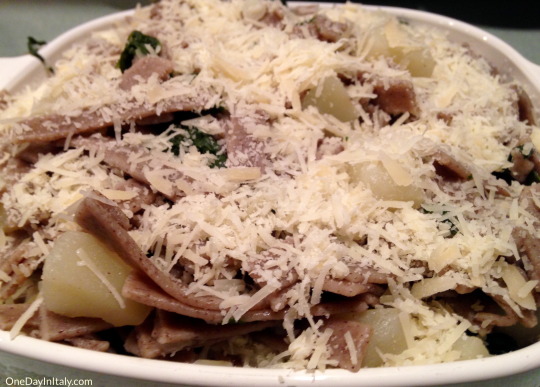
After removing the garlic and fresh sage leaves (if you used them), pour the warm butter carefully over the entire dish. Traditionally, the warm butter is supposed to be enough to melt the cheeses. However, after living in Milan for a while and watching several people prepare this dish, I discovered that each one of them put this beautiful dish in the oven for a few minutes to aid the process.
I set my oven very low, around 175°F, and put the baking dish in the oven for 5-10 minutes, until I could see the cheese on top nicely melted but not browned.


Ecco! Pizzoccheri della Valtellina!
Comments
comments



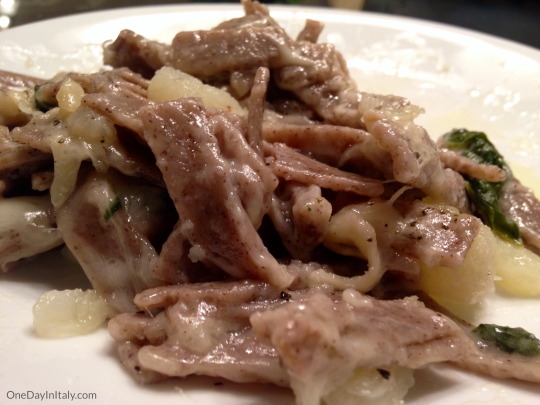












Leave a Reply